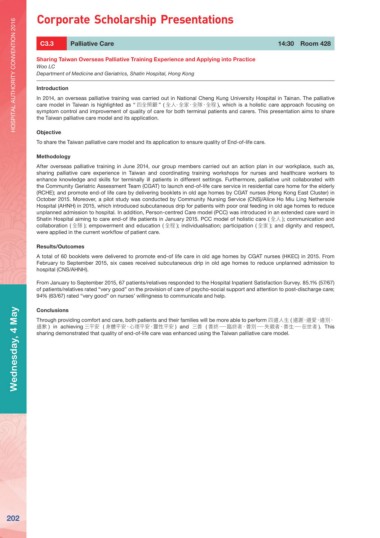Page 204 - HA Convention 2016 [Full Version]
P. 204
HOSPITAL AUTHORITY CONVENTION 2016 Corporate Scholarship Presentations
C3.3 Palliative Care 14:30 Room 428
Sharing Taiwan Overseas Palliative Training Experience and Applying into Practice
Woo LC
Department of Medicine and Geriatrics, Shatin Hospital, Hong Kong
Introduction
In 2014, an overseas palliative training was carried out in National Cheng Kung University Hospital in Tainan. The palliative
care model in Taiwan is highlighted as “ 四全照顧 ” ( 全人、全家、全隊、全程 ), which is a holistic care approach focusing on
symptom control and improvement of quality of care for both terminal patients and carers. This presentation aims to share
the Taiwan palliative care model and its application.
Objective
To share the Taiwan palliative care model and its application to ensure quality of End-of-life care.
Methodology
After overseas palliative training in June 2014, our group members carried out an action plan in our workplace, such as,
sharing palliative care experience in Taiwan and coordinating training workshops for nurses and healthcare workers to
enhance knowledge and skills for terminally ill patients in different settings. Furthermore, palliative unit collaborated with
the Community Geriatric Assessment Team (CGAT) to launch end-of-life care service in residential care home for the elderly
(RCHE); and promote end-of life care by delivering booklets in old age homes by CGAT nurses (Hong Kong East Cluster) in
October 2015. Moreover, a pilot study was conducted by Community Nursing Service (CNS)/Alice Ho Miu Ling Nethersole
Hospital (AHNH) in 2015, which introduced subcutaneous drip for patients with poor oral feeding in old age homes to reduce
unplanned admission to hospital. In addition, Person-centred Care model (PCC) was introduced in an extended care ward in
Shatin Hospital aiming to care end-of life patients in January 2015. PCC model of holistic care ( 全人 ); communication and
collaboration ( 全隊 ); empowerment and education ( 全程 ); individualisation; participation ( 全家 ); and dignity and respect,
were applied in the current workflow of patient care.
Wednesday, 4 May Results/Outcomes
A total of 60 booklets were delivered to promote end-of life care in old age homes by CGAT nurses (HKEC) in 2015. From
February to September 2015, six cases received subcutaneous drip in old age homes to reduce unplanned admission to
hospital (CNS/AHNH).
From January to September 2015, 67 patients/relatives responded to the Hospital Inpatient Satisfaction Survey. 85.1% (57/67)
of patients/relatives rated “very good” on the provision of care of psycho-social support and attention to post-discharge care;
94% (63/67) rated “very good” on nurses’ willingness to communicate and help.
Conclusions
Through providing comfort and care, both patients and their families will be more able to perform 四道人生 ( 道謝、道愛、道別、
道歉 ) in achieving 三平安 ( 身體平安、心理平安、靈性平安 ) and 三善 ( 善終 — 臨終者、善別 — 失親者、善生 — 在世者 ). This
sharing demonstrated that quality of end-of-life care was enhanced using the Taiwan palliative care model.
202

